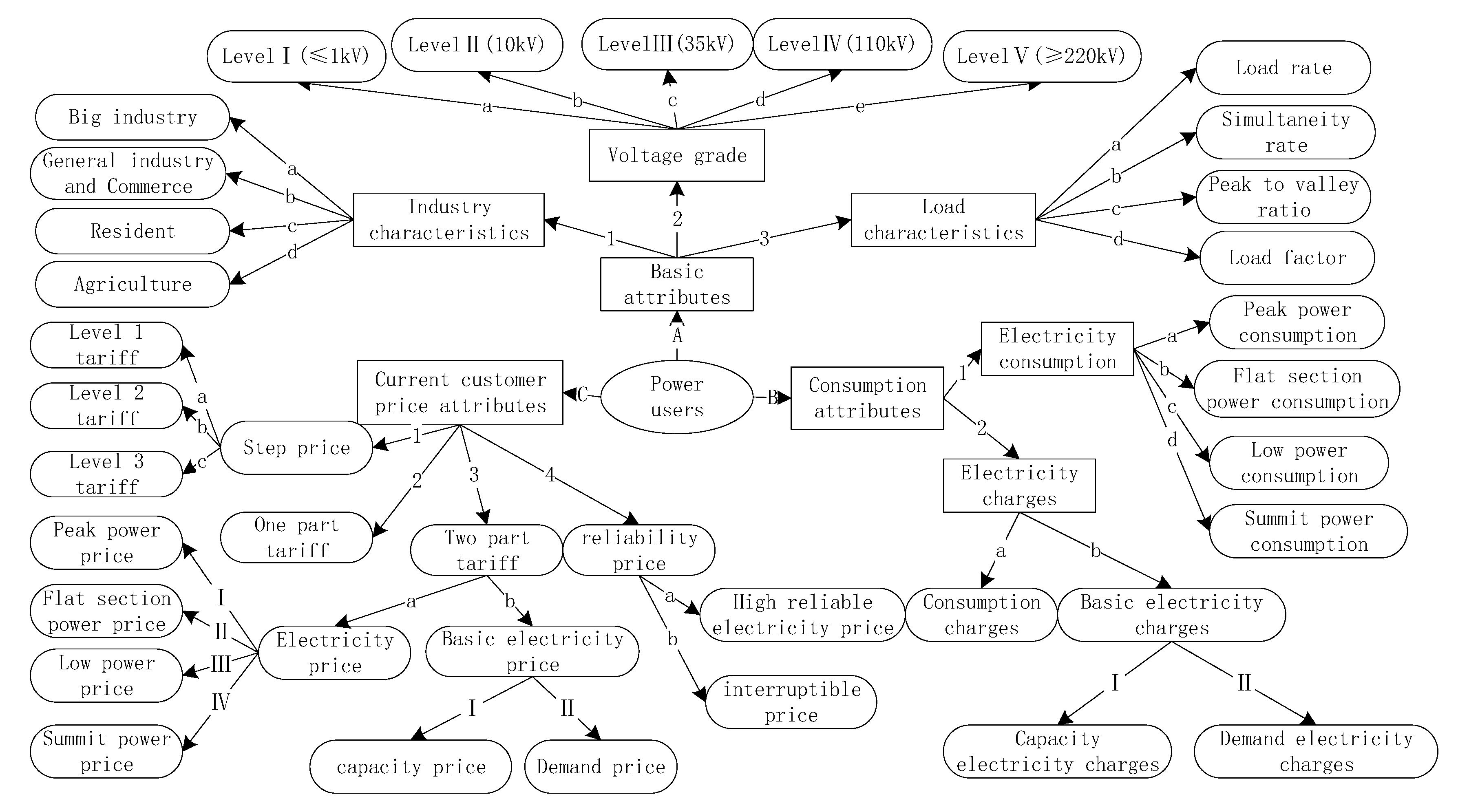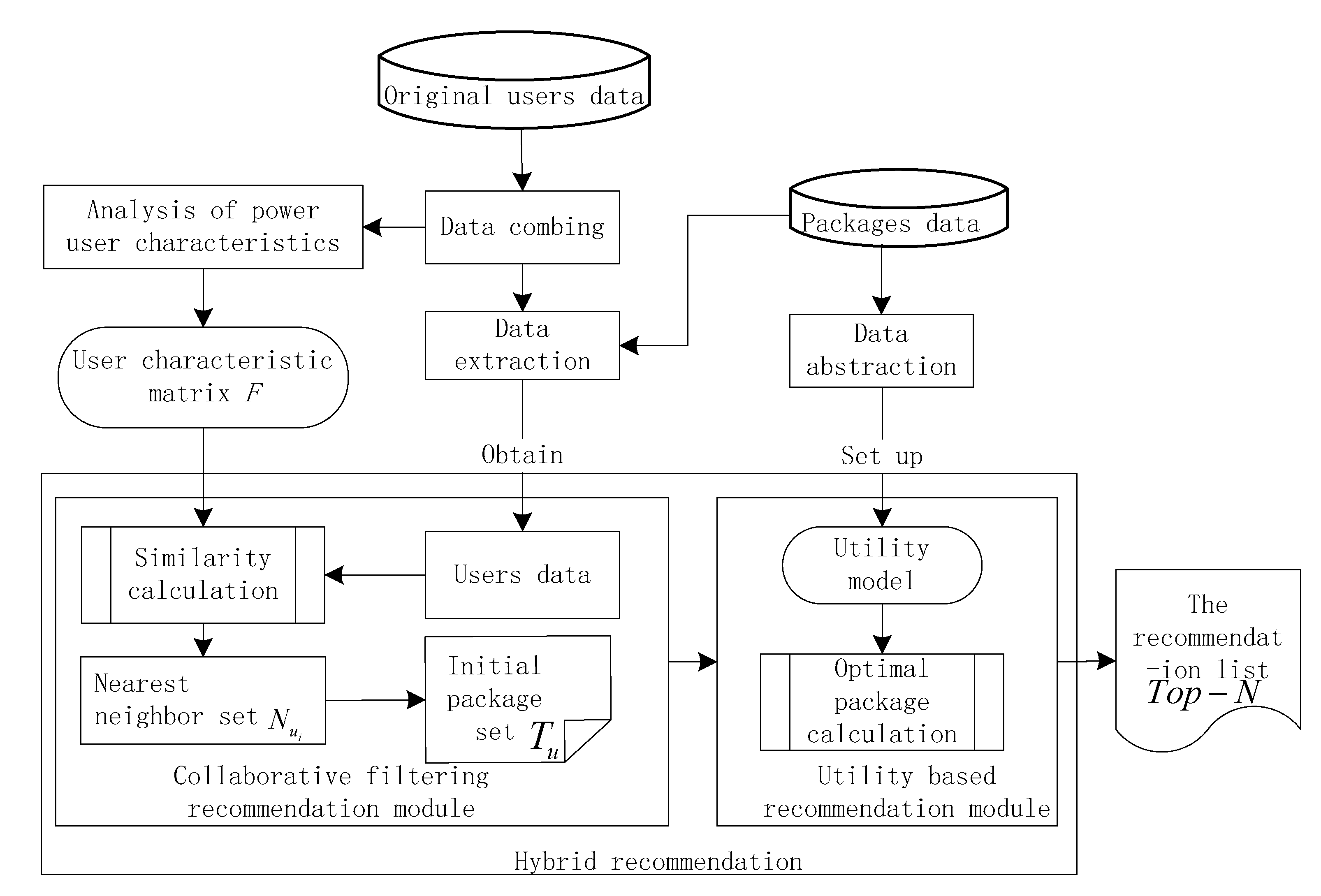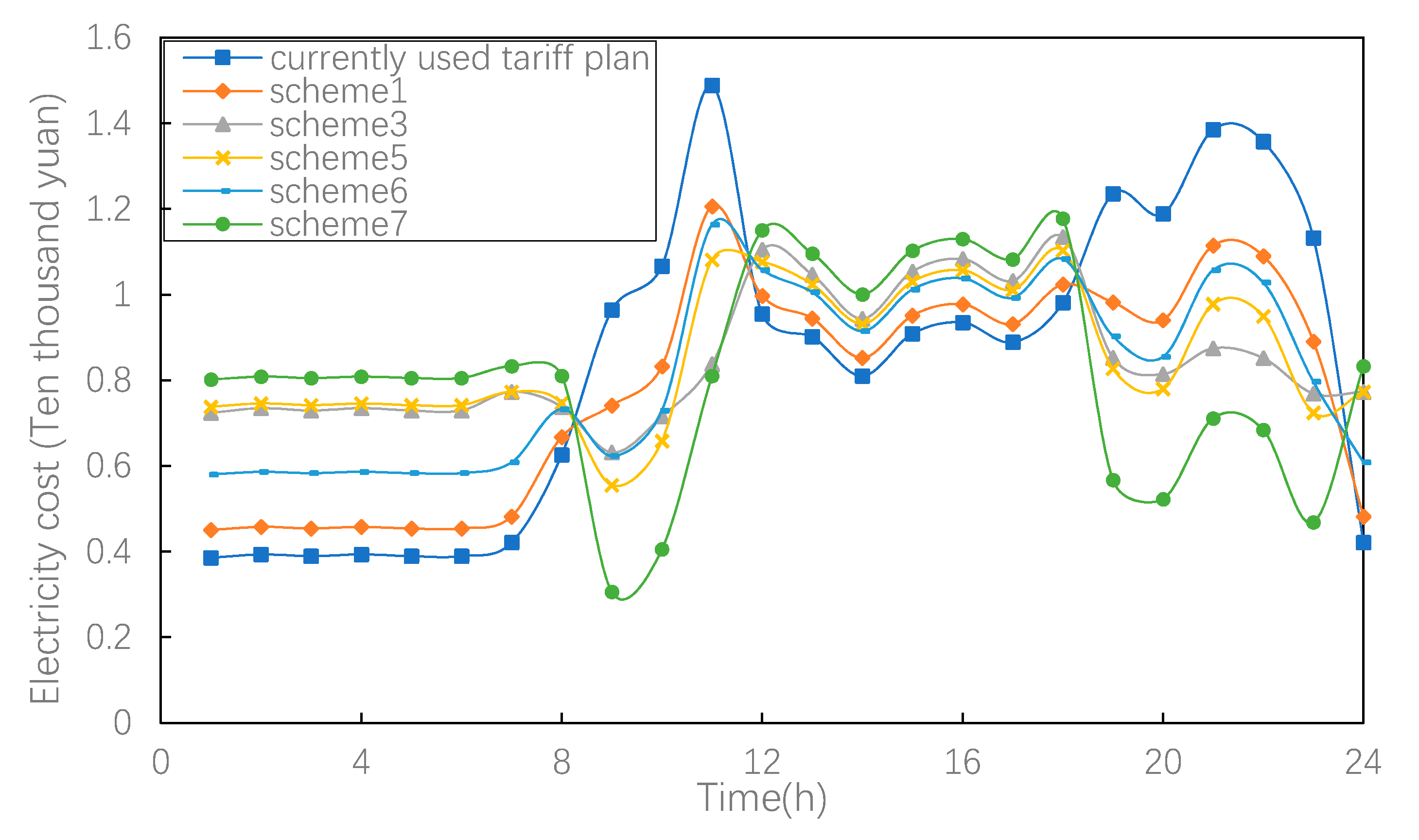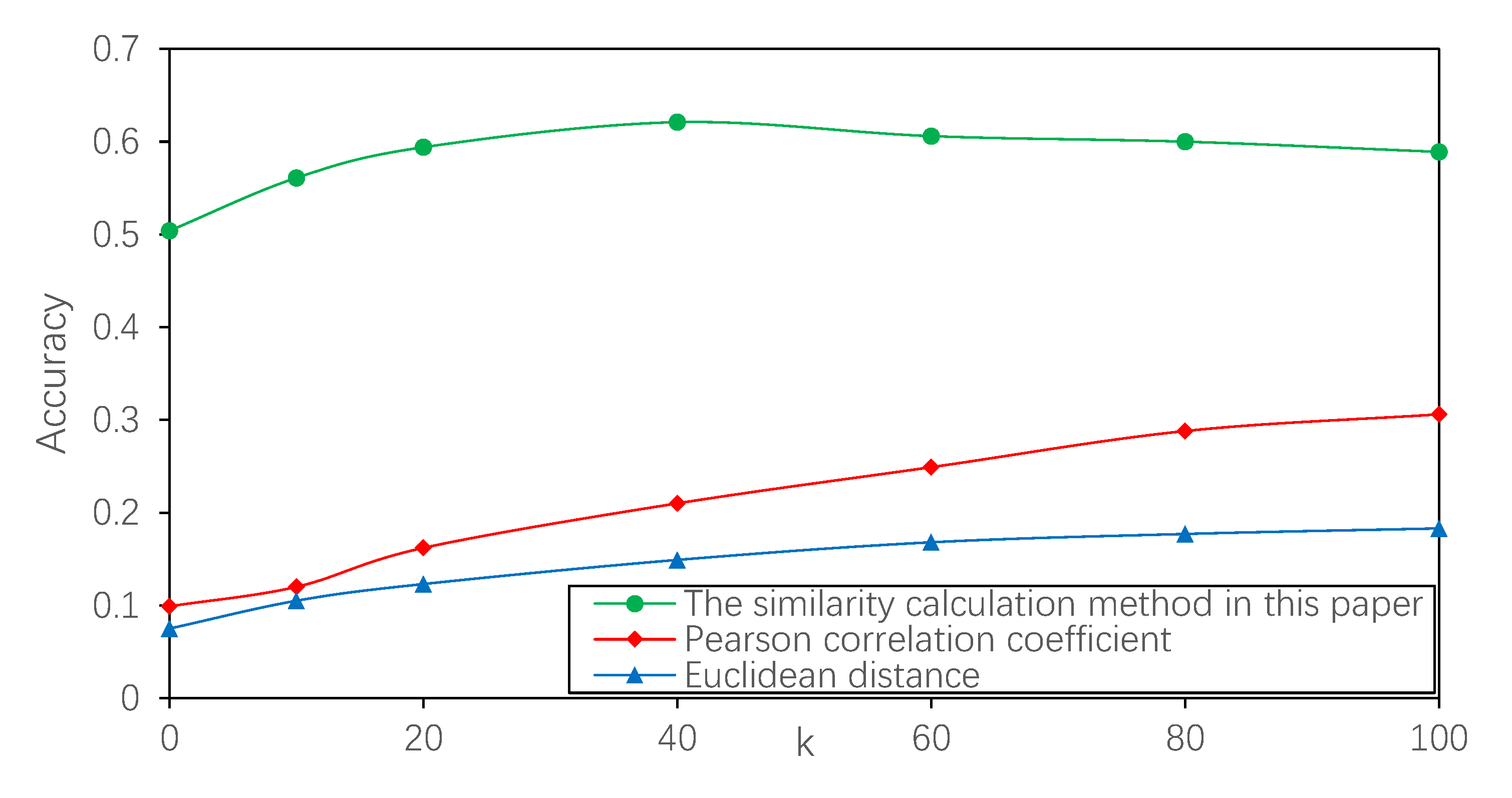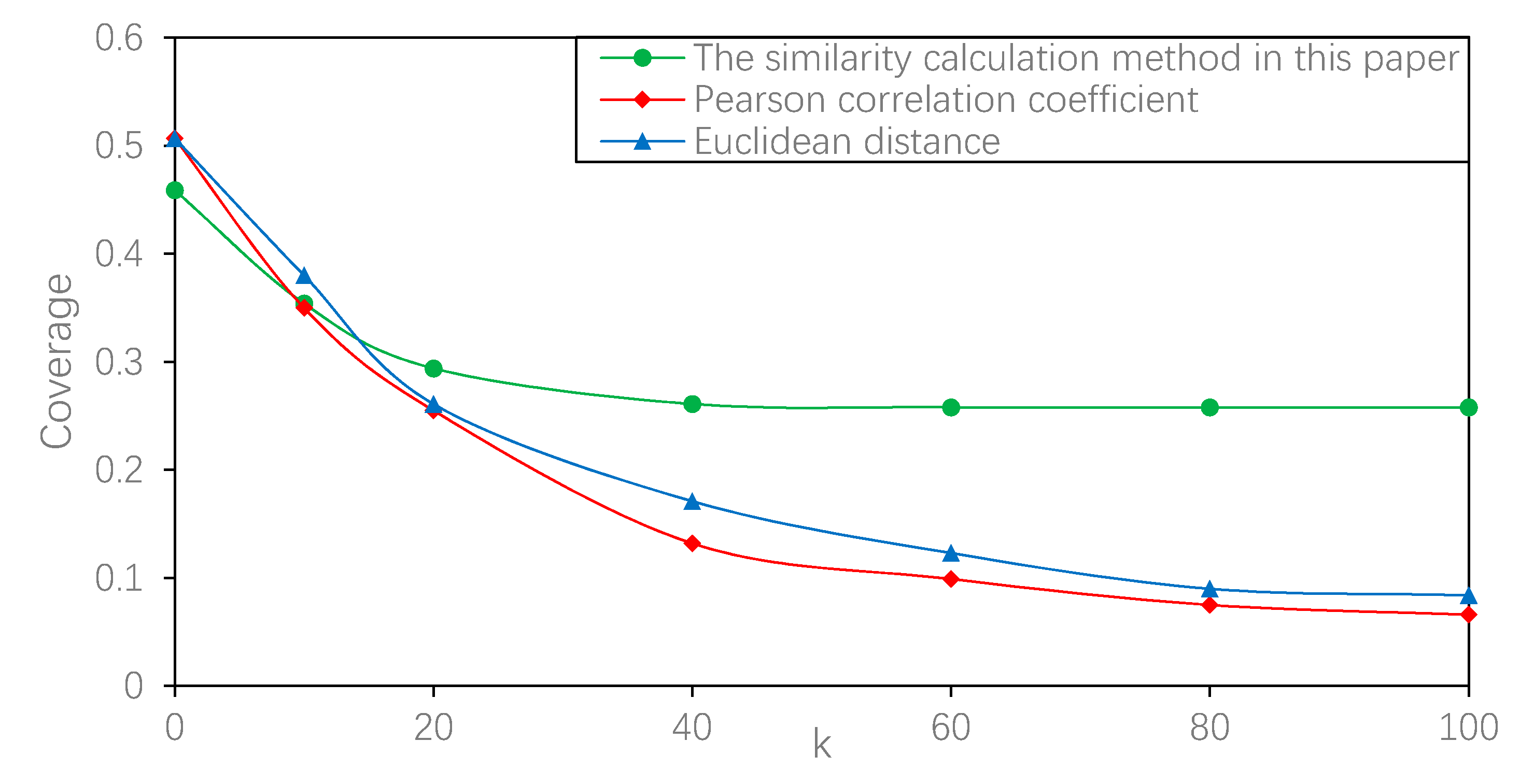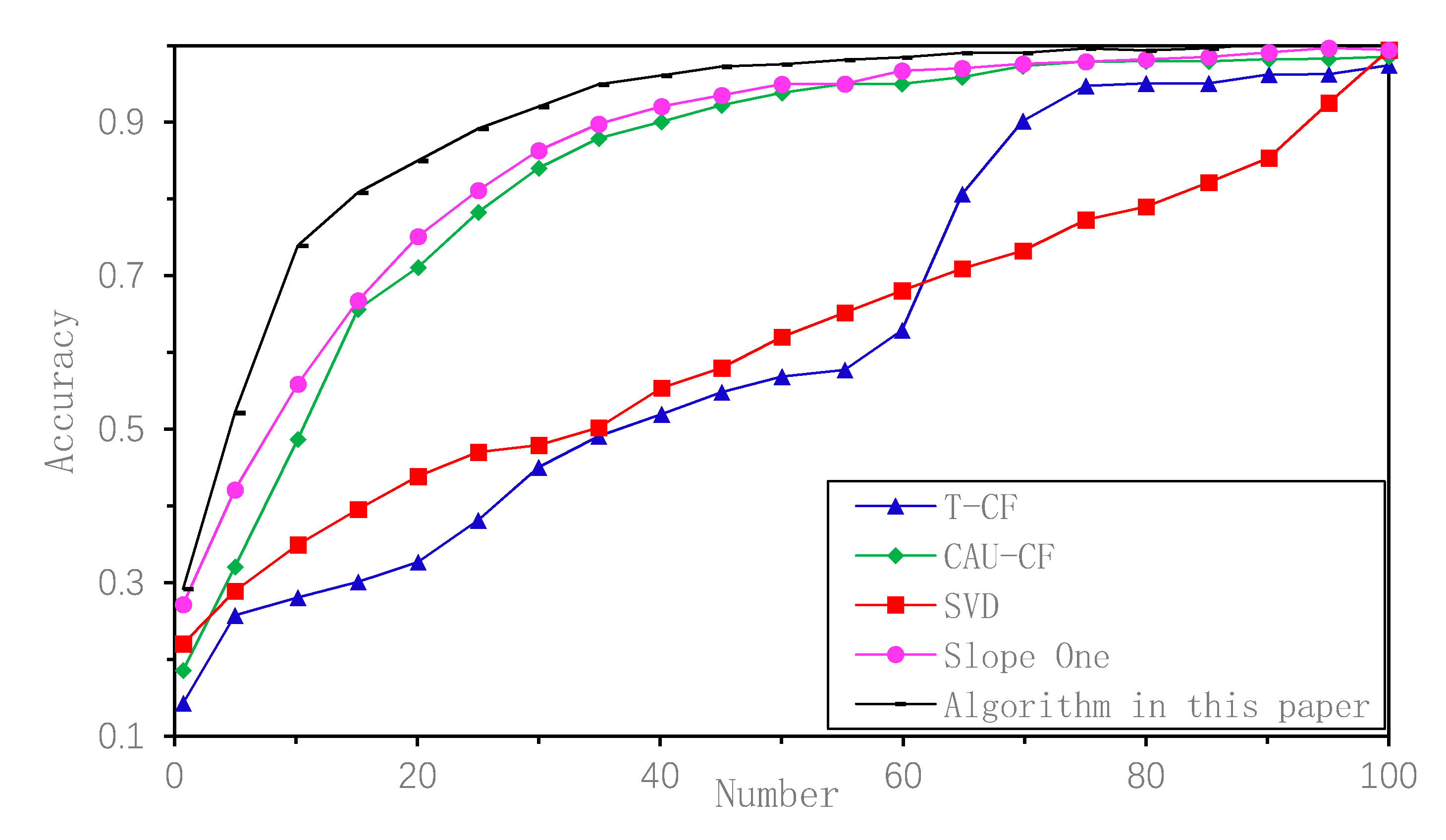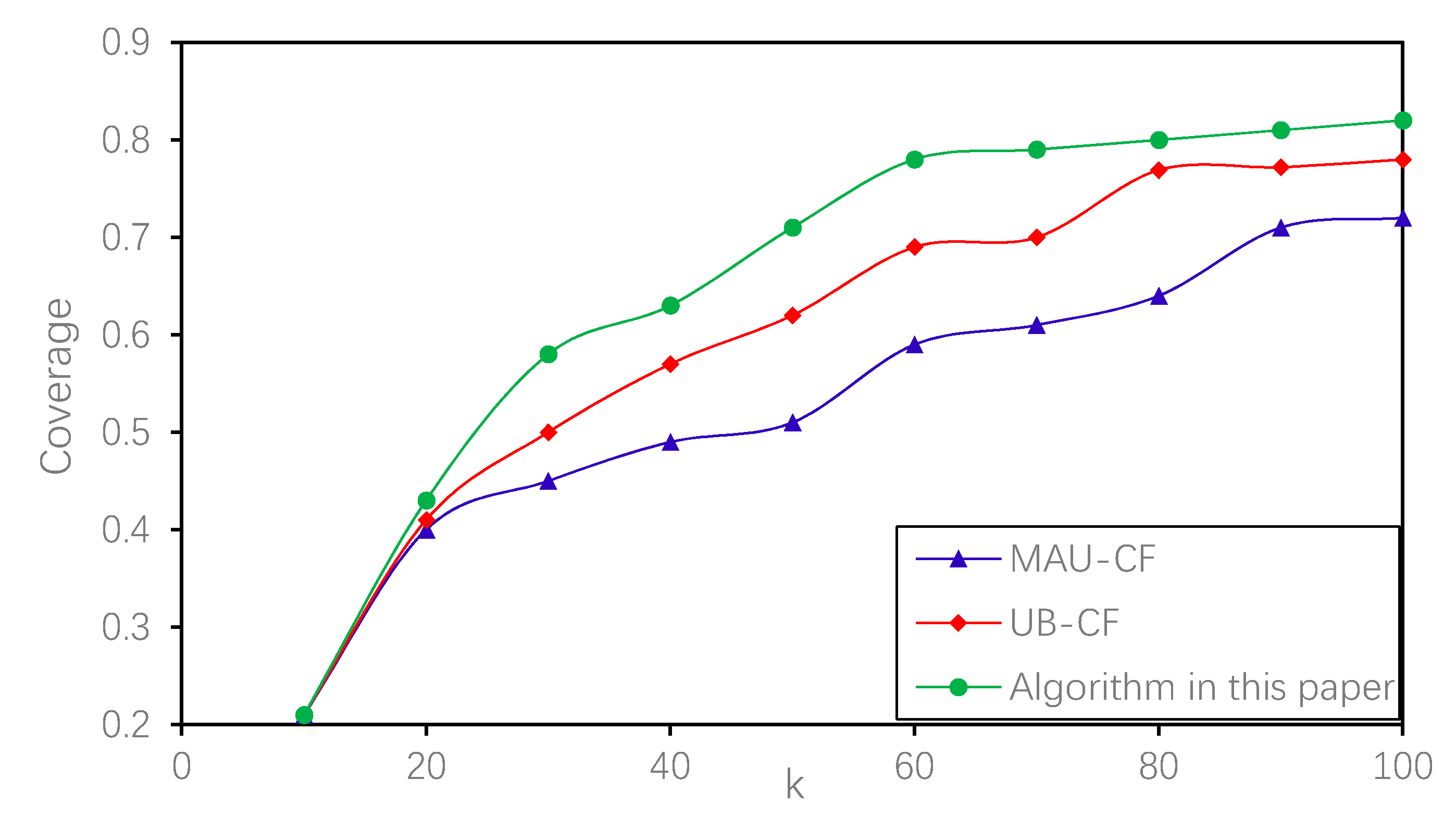1. Introduction
Since 2015, with the promulgation of “electric power reform No. 9 document” and supporting documents, the level of China’s retail electricity market liberalization has been continuously improved, the retail electricity market users’ right of choice has been gradually opened, and diversified power retail competitors have emerged rapidly [
1,
2]. According to incomplete statistics, by the end of March 2018, there were more than 3342 electricity retail companies registered nationwide [
3]. With new participants entering the retail electricity market, the market competition is fierce, and power users have the opportunity to choose from a number of different retailers [
4,
5]. The relationship between power users and suppliers are being altered [
6]. A retail electricity price package is a new type of power product which is developed according to the characteristics of users. Combined with the characteristics of users, a variety of electricity price packages are designed to meet the differentiated needs of user [
7]. According to statistics, as of September 2016, there are more than 9000 electricity price packages for users to choose in the end market of Texas, the United States. Through comprehensive evaluation, the price comparison website provides users with price package recommendation service [
8,
9]. Since 1998, when the right of choice for users was released in the UK, all users have the freedom to choose electricity suppliers [
10]. In the market-oriented transaction, there are many kinds of retail electricity price packages with complex contents, which make it difficult for users to find the most suitable price package for their own electricity demand [
11,
12].
In view of the large amount of information of user characteristics and the personalized power demand of power users, it is necessary to introduce a recommendation system [
13] to help users quickly select suitable retail electricity price packages. A recommendation system is an effective way of information filtering. It can solve the problem of "information overload" and realize professional recommendation service. The core technology of a recommendation system is a recommendation algorithm, which includes content-based recommendations, collaborative filtering recommendations, and hybrid recommendation algorithms [
14]. At present, there are some services that directly or indirectly help users choose power products in the power market. Direct methods are popular on online product recommendation systems, such as Power to Choose, Energy Made Easy (EME), Check24, and iSelect [
15,
16,
17,
18]. The basic principle is to find cheaper power products by directly comparing the costs of all plans. The cost of a product is calculated based on the customer’s total electricity usage and the charge rates of the electricity price. Generally, total electricity consumption is estimated based on the corresponding values on the latest electricity bills. A major limitation of the direct manner is that the total power estimate is inaccurate due to neglect many other key factors affecting electricity consumption, such as simultaneity rate and peak valley ratio of customers. Another negative is that these tools don’t recognize prices in different periods of the tariff package. Customers have to choose a package with the lowest average electricity price, but it may lead to higher electricity charges in the end. Different from directly comparing costs of all packages, the indirect manner is to recommend electricity packages according to customer characteristics and similar customers’ electricity consumption plans [
19,
20]. In order to provide recommendation services to target users, the recommendation system analyzes its energy consumption mode, finds users with similar energy consumption mode from the user knowledge base, and then recommends the most appropriate pricing scheme to the target user [
21]. Yuan discuss the scheme recommendation of power price by analyzing the characteristics of power users. According to the data of household appliances obtained by the power plan recommendation system, they can choose the appropriate power scheme for the users [
22]. Yang tapped users’ potential preferences based on tag collaborative filtering algorithm, and then recommend products in the user’s preferences scope. These methods solve the problem of single Recommendation Index of traditional methods [
23].
In the above study, the power product recommendation is realized by analyzing the user’s power demand preference and historical power use. There is no comprehensive consideration of the attributes of an electricity price package, which affects the accuracy of recommended results. Some studies consider the sensitivity of users to the attributes of an electricity price package. Based on the collaborative filtering algorithm, Shun established a new matrix decomposition algorithm, which can recommend the most appropriate pricing scheme to any target user according to the distribution of electricity consumption and the user’s preference for each pricing scheme [
24]. Diego proposed a recommendation system that can collect consumption data from electronic products in a home, obtain information on electricity prices in the Internet. Then provide recommendations combine consumption data of users and attributes of price package [
25]. The system can optimize the power consumption in different periods of the day, and save users’ expenses. The weakness of the existing plan recommendation method is that it overestimates the abilities of the residential user to estimate the price package attributes, e.g., the price of electricity price package in different periods. Due to the lack of accurate evaluation of attributes of the price package, the suggestions provided by these indirect ways are unreliable. On the whole, more and more researches are based on the score of user evaluation to project and complete the recommendation. The existing scholarship in this field, however, tends to overlook the discussion of the characteristics of new users and lacks the recommendation of new projects. Another limitation associated with the package recommendation lies with the incomplete description of user characteristics. Lack of unified quantitative analysis of quantitative and qualitative characteristics of users. The sensitivity of users to package utility is ignored, and the multidimensional attribute of package is not considered comprehensively.
Based on the above research background, we proposed a hybrid recommendation method of retail electricity price packages based on the characteristics of power users and multi-attribute utility. On the one hand, the characteristics of power users reflect the current power demand of users [
26]. The traditional recommendation algorithm calculates the similarity between users according to the customer’s rating of products, so as to realize product recommendation, such as recommendation of movies and books [
27,
28,
29,
30]. In view of the lack of user rating data, this paper uses a tree structure to describe user characteristics comprehensively. The proximity measure is introduced to quantify the mixed features of the users. By calculating the similarity of user characteristics, the initial recommendation of tariff package is completed. This method does not rely on the scoring data of customer evaluation package, and can solve the problems of data sparsity and cold start in collaborative filtering recommendation method, and can cover users with special interest preferences. On the other hand, considering the sensitivity of users to the utility of electricity price package [
31], a collaborative filtering recommendation algorithm based on multi-attribute utility is proposed. The core problem of the algorithm is to build multi-attribute utility function to calculate the comprehensive utility of electricity price package to users [
32,
33]. Multi attribute utility theory can analyze the utility of a recommendation package to users from the perspective of personalized utility [
34,
35]. At the same time, non-package attributes, such as vendor reliability and product availability, can be considered in the utility calculation. The algorithm is suitable for the multi-attribute characteristics of power price package. It solves the problem that users can’t judge the utility of electricity price package intuitively, and provides the basis for users to choose package. Therefore, combined with the characteristics of power users and multi-attribute utility, the hybrid recommendation can select the most suitable power price package for the target users. At the same time, the hybrid recommendation algorithm presented in this paper is suitable for the recommendation of new projects without scoring data. It is also suitable for recommendation of items with multiple attributes, such as a mobile package recommendation.
The purpose of this study is to design a method for recommendation services and improve the shortcomings of traditional recommendation methods. This paper demonstrates whether the hybrid recommendation method combined with user characteristics and utility of electricity price package is reasonable. The empirical study shows that the recommended electricity price package can significantly reduce the total cost of electricity consumption compared with the current electricity consumption plan of the target users. In addition, we found that considering user characteristics and user preferences for the attributes of electricity price package can avoid the impact of active users and popular packages on the results and increase the coverage of recommendation results.
This study expands research on package recommendation from three main perspectives. Firstly, analyzing the characteristics of power users from three dimensions of basic attributes, consumption attributes and current user’s electricity price attributes. The proximity measure is introduced to quantify the different data types of user characteristics. We can find the similar neighbors of the target users more accurately, and determine the initial recommendation set of an electricity price package. Secondly, based on the multi-attribute utility theory, this paper analyzes the comprehensive utility of retail electricity price package to users from the two aspects of electricity expenditure and electricity consumption mode. Finally, based on the power users’ similarity matrix and comprehensive utility of electricity price package, the hybrid recommendation model of a price package is constructed by using collaborative filtering and utility recommendation algorithm. This method can recommend projects for new users, and can also recommend new projects to all users. The results of the paper are useful for the companies to provide better recommendation services, guide user to choose a suitable package. To the best of our knowledge, there are few researches on the retail electricity price package recommendation method in China. Therefore, this paper makes a contribution to the research in this field.
This paper is organized as follows:
Section 2, the hierarchical relationship of power user characteristics is established by using a tree structure diagram and discussing user characteristics and building user characteristics matrix.
Section 3, the proximity measurement method is used to quantify the user features, and the similarity function of user features is established. Based on the multi-attribute utility theory, the utility function of retail electricity price package to users is constructed. On this basis, the hybrid recommendation model of retail electricity price package is constructed.
Section 4 combined with the hybrid recommendation model, taking Tianjin as an example, the paper analyzes the recommended results of electricity price package, and verifies the effectiveness of the model.
Section 5 gives conclusion and future works.
3. Hybrid Recommendation Model Based on Power User Characteristics and Multi-Attribute Utility
The typical user set selected in this paper is the basis for formulating the electricity price package. Each price package corresponds to a typical user. The similarity between the typical user and the target user is calculated, and the similar user set is obtained by ranking the similarity from high to low. The retail electricity price package corresponding to the similar user set constitutes the initial recommendation set of the target user. Then calculate the utility value of the electricity price package to the target user in the initial recommendation, and recommend the retail electricity price package with the largest utility value to the target user.
3.1. Similarity Analysis of Power Users’ Characteristics
The characteristics of power users include different data types, which to a certain extent determines the preferences of consumers for retail price electricity packages.
According to the proximity measurement methods of different types of data proposed by Han, the attributes of power user characteristic data are divided into nominal type, numerical type, and ordinal type, as shown in
Table 1.
It can be seen from
Table 1 that the characteristic attributes of power users belong to a mixed type, and the proximity measurement method is applied to analyze the mixed characteristics of the power users. Assuming there are
target users in total, which is represented by the set
, where
is the
target user. Take
typical users corresponding to the recommended price package of the electricity selling company, which is represented by the set
. Where
represents the typical users corresponding to the
package. The dissimilarity between the typical user
and the target user
is calculated by the following formula.
where
represents the difference between the typical user
and the target user
;
represents the power user characteristics;
represents the number of power user characteristics;
is the indicator;
is the contribution of feature
to the dissimilarity between users
and
.
The fetching value principle of the : If or is missing (That is, the target user or typical user does not have a measure value of characteristic ), or , and is an asymmetric binary user feature, then ; otherwise .
The fetching value principle of the :
- (1)
If the characteristic of power users is numerical type, then , where can take all the non-missing value of the characteristics of the power user.
- (2)
If the characteristic of power users is nominal type or binary type, when the characteristic value , then ; otherwise, .
- (3)
If the characteristics of power users are ordinal: calculate ranking and , where, represents the ranking of state in the characteristic of power users; is the number of ordered states of , and treat as a numerical type.
Calculate the similarity between target users
and typical users
:
where
is feature similarity of power users.
Building user feature similarity matrix based on user feature similarity calculation results, which is a matrix of
order and represented by
:
where
is the feature similarity value between target user
and typical user
.
3.2. Multi Attribute Utility Function of Electricity Price Package
When users purchase the electricity price package, they tend to choose the package with greater utility. In this paper, multi-attribute utility theory is applied to evaluate the utility of electricity price package attributes to users, providing scientific basis for users to purchase package. This paper explores the impact of the attributes of the electricity price package to the utility of the target user from the two aspects of electricity expenditure and electricity consumption mode.
Assuming that each electricity price package has attributes, indicates the value of the attribute of the electricity price package. Then the electricity price package can be expressed as a vector composed of attribute values .
Let
have
discretized attribute values, which form the value set of attribute
:
where
represents the
value of attribute
. The attribute
of the electricity price package can only take one value.
(1) Utility of Attribute Value of Electricity Price Level to Users
Considering the different price levels of the electricity price package during each period, the peak and valley power consumption of users in different seasons is first predicted, and calculate the monthly average power consumption. Then, the user’s electricity consumption fee is estimated based on the price level of the current electricity consumption plan and the predicted power consumption. The formula is:
where
is the consumption cost of the
target user if they choose the
electricity price package;
is the estimated power usage of the
target user for the
time period;
and
represent, respectively, the power energy price and the capacity price of the
price package for the
time period.
represents the total number of users,
represents the total number of retail power price packages, and
is the number of time periods.
On the other hand, for the
target user, before buying a certain retail electricity price package, there will be a basic electricity consumption budget, which is represented by
. The difference between
and
represents the benefits of the
electricity price package. The greater the difference, the higher the purchase intention of users. The formula is as follows:
where
is the benefit of the
target user choosing the
electricity price package.
(2) The Utility of Structure Attribute of Retail Electricity Price Package to Users
Structure attribute is the key factor that affects the utility of electricity price package to users. The peak and valley period of price package affects the way users use electricity.
Before implementing the retail electricity price package, the user does not have a response because of the same price of each period, so the user will choose the most comfortable way to use electricity, which usually acts as the reference of the user’s satisfaction of electricity consumption mode. After the implementation of the electricity price package, the structure attribute of the price package causes the change of the power consumption mode of the users and forms a new load curve. The difference value between the electricity quantity and the reference in each period after the implementation of the tariff package reflects the applicability of the package. The smaller of the difference value, the more willing users are to buy. The formula is as follows:
where
represents the utility of retail electricity price package structure attribute to users;
is the power consumption of
period before the implementation of the electricity price package;
represents the power consumption of period
after the implementation of the retail electricity price package.
(3) Comprehensive Utility of the Electricity Price Package to Users
The comprehensive utility of the electricity price package to users is the weighted average of the utility of electricity price level and structure attribute to users. The formula is as follows:
where
represents the comprehensive utility of retail electricity price package to users.
represents the proportion of utility generated by electricity price level of retail electricity price package to comprehensive utility.
represents the proportion of utility generated by the structural attribute of retail electricity price package to the comprehensive utility.
The weight is determined according to the number of times when users browse the attributes of electricity price package. The price package contains the attribute and attribute value of user preference. If the attribute value of attribute appears more times, the weight of attribute is greater. For example, the user’s browsing records are all about the price level in peak period, which shows that the price level has a great impact on the user’s utility, so the price level should be given a greater weight.
Suppose user
has clicked to view
retail electricity price packages before making a purchase plan. Attribute value a of attribute
appears
times. If
deviates from the average frequency
and is closer to
, the greater the impact of attributes on user utility, the greater the weight of attribute
should be given, otherwise, the weight of attribute
is smaller. The weight formula of the attribute is:
where
is the weight that affects utility;
represents the number of times that attribute value
of attribute
appears;
is the average number of occurrence of attribute values;
represents the sums of electricity price package attributes.
3.3. Hybrid Recommendation Algorithm Based on User Characteristics and Electricity Price Package Utility
The recommendation is completed by analyzing the characteristics of power users and the utility of retail electricity price package. First, the collaborative filtering recommendation is applied to get the initial set of retail electricity price package recommendations, and then the utility recommendation means is applied to get the final list of recommendations for the target users. The specific steps are as follows:
Input: characteristic matrix of power users, attribute value of retail price package.
Output: Retail electricity price package recommendation set of target user .
Step 1: Explore the characteristics of power users and build the user characteristic matrix .
Step 2: Based on the user’s characteristic matrix , the feature similarity between the typical user and the target user is calculated according to formula (3), and the user’s feature similarity matrix is obtained.
Step 3: According to the value of similarity , the typical users are sorted, and the typical users with high similarity are selected to form a similar user set, which is represented by .
Step 4: Find the code of the retail price package corresponding to , and eliminate the duplicate code, that is, get the initial retail price package recommendation set of user .
Step 5: According to the multi-attribute utility model, the utility of the initial electricity price package to users is calculated. The utility value is sorted from high to low and the recommendation list of the target user is obtained to recommend to the user.
This paper presents a flow chart of hybrid recommendation algorithm based on the characteristics of power users and the utility of retail power price package, as shown in
Figure 2.
